the place where Paleontology and Paleoanthropology meets Philately
Dominica
Not to be confused with the Dominican Republic
Dinosaurs and other prehistoric animals on stamps and postmarks of Dominica
| << previous country | back to index | next country >> |
Contents:
- Country overview
- Philately of Dominica
- Official stamps of Dominica related to Paleontology and Paleoanthropology
- Other stamps of Dominica to consider
- Commemorative postmarks of Dominica related to Paleontology
- References
- Acknowledgements
Dominica, officially the Commonwealth of Dominica, is an island country in the Lesser Antilles region of the Caribbean Sea, south-southeast of Guadeloupe and northwest of Martinique.
Its area is 750 square kilometers and the highest point is Morne Diablotins, at 1,447 meters elevation. The population was 72,301 as of the 2014 census. The capital is Roseau, located on the leeward side of the island.
The island was originally inhabited by the Kalinago and later colonized by the Europeans, predominately by the French, who arrived at the island on Sunday, 3 November 1493 ("Sunday" = "Dominica" in Latin). Great Britain took it over in 1763 after the Seven Years' War and gradually established English as the official language. The island republic gained independence in 1978. [R1]
On 4 May 1874, Dominica issued its first stamps, with a set consisting of 1d, 6d, and 1-shilling values. The design was a profile of Queen Victoria in an oval frame with "DOMINICA POSTAGE" in the band of the frame. Dominica adopted the British West Indies dollar in 1949, and the first issue denominated in the new currency was the Universal Postal Union 75th anniversary commemorative in October of that year. [R2]
Official stamps of Dominica related to Paleontology: dinosaurs and other prehistoric animals
| 23.06.1992 "Dinosaurs" | 08.09.1995 "Prehistoric animals" [1] | 01.06.1999 "Prehistoric animals" |
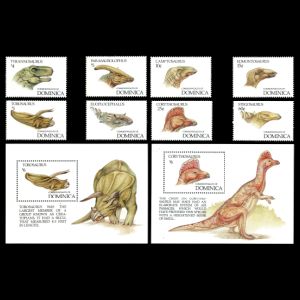 |
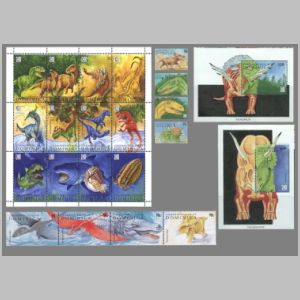 |
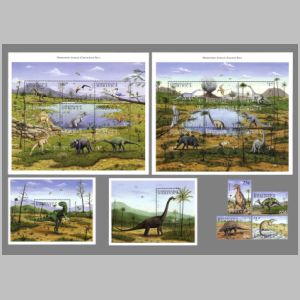 |
| 24.01.2005 "Prehistoric animals" | ||
 |
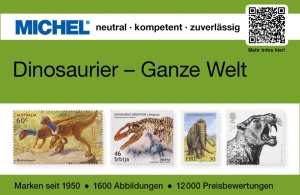
|
|
Notes:
[1] Many Dinosaur names are misspelled.
Other stamps of Dominica to consider: contributors to Paleontology science
| 17.11.1989 "200 years of American presidency" [A1] | ||
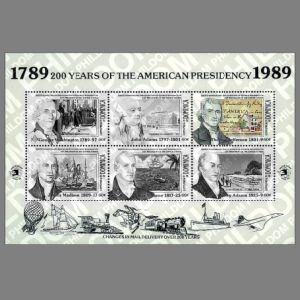 |
|
|
Notes:
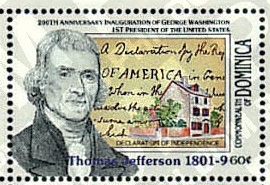
|
|
Thomas Jefferson on stamp of Dominicana 1989. MiNr: 1246 Scott: 1204c |
[A1] Thomas Jefferson, the third American president, who was recognized as a pioneer in ethnology, geography, anthropology and our subject paleontology. Thomas Jefferson is rightfully renowned as the principal author of the Declaration of Independence, the Third President of the United States, and a champion of Liberty. But he was also a central player in the beginnings of American paleontology.
In addition, his participation occurred at a time when people were struggling with the ideas of fossils as evidence of past life, of extinction, and of an Earth far older than the Biblical account.
Some of the fruits of Jefferson's paleontology became part of the collections at the American Philosophical Society in Philadelphia. Beginning in 1849 these holdings were transferred over to the Academy of Natural Sciences of Philadelphia, where they are currently housed.
USA stamp of Thomas Jefferson issued in 1851 is the first Paleontology related stamp ever. Since than many stamps of Thomas Jefferson are issued in USA and around the world. [R3]
Commemorative postmarks of Dominica related to Paleontology: dinosaurs
| 23.06.1992 "Dinosaurs" [FDC] | ||
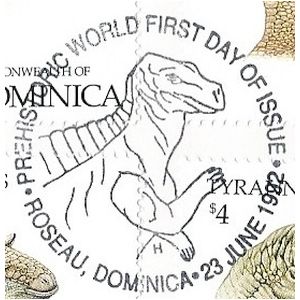 |
|
|
References:
- [R1] Dominica: Wikipedia, WikiTravel, FlagCounter.
- [R2] Postal History and Philately of Dominica:
Wikipedia,
Links to official website of the Post Authority, stamp catalog and a list of new stamps of Denmark are here. - [R3] Thomas Jefferson: Wikipedia, USA stamp from 1954 and USA stamp from 1968
Acknowledgements:
Many thanks to Dr. Peter Voice from Department of Geological and Environmental Sciences, Western Michigan University, for the draft page review and his very valuable comments.
| << previous country | back to index | next country >> |